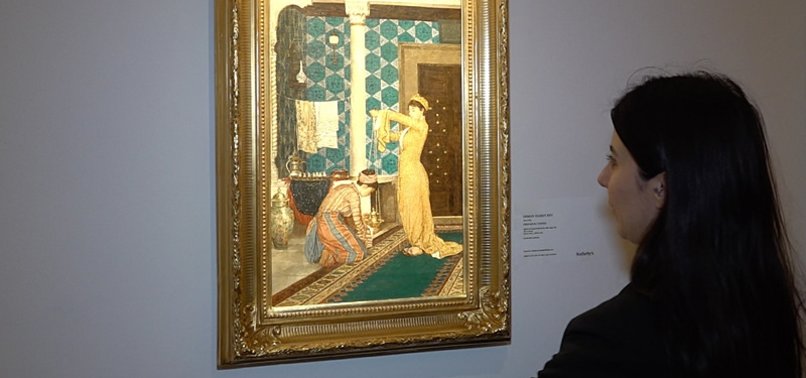This spring, the art world turns its gaze on London, where one of the most significant rediscoveries in recent Orientalist art will go under the hammer at one of London’s important auction house Sotheby’s.
On April 29, as part of its highly anticipated Orientalist Art sale, the auction house will present Preparing Coffee, a long-lost painting by Osman Hamdi Bey — arguably the most revered figure in the canon of Ottoman painting.
Estimated at £1-1.5 million (about $1.3-2 million), the composition, Preparing Coffee, from 1881 has resurfaced after more than a century in private European collections, known until recently only from a black-and-white photograph taken in the same year by renowned photographers Pascal Sebah and Policarpe Joaillier.
“This was a very unexpected rediscovery,” explains Claude Piening, senior international specialist of European paintings at Sotheby’s.
“I was approached by a gentleman whom I’ve known for many years, who proposed this picture to me. He had recently bought it from someone else who had bought it a few years ago, from the family — the European family — in whose possession it had been for almost 75 years, certainly since around 1930.”
– From Istanbul to Vienna to London
First acquired around 1910 by Prince Sadiq Yadigarov, an art collector from Georgia, it passed to his son Archil, and then, around 1930, to a private collector in Vienna — related to Archil by marriage — where it remained by descent until 2008.
Since then, it has been held in another Austrian private collection until its recent emergence.
Set within a richly tiled, colonnaded interior — perhaps an imagined harem complex in Istanbul’s Topkapi Palace — it depicts two young women preparing a ritual coffee.
The setting is fictional, but constructed with exquisite attention to detail, a “sumptuous and jewel-like impression of luxe,” as Sotheby’s catalogue describes.
– Coffee, gateway to a broader cultural dialogue.
Coffee, a central motif in Middle Eastern life, becomes the gateway to a broader cultural dialogue.
“I think it’s wonderful to have that as the central motif of the picture. The picture shows the coffee jug with the zarfs, which are the cup holders. That’s obviously a quintessentially Turkish — or should I say, Ottoman — feature of the picture,” Piening notes.
Objects within the painting add layers of cultural symbolism and material wealth: a velvet and metal-thread tablecloth supporting the coffee pot and zarfs, a Mamluk brass bowl, Chinese porcelain vases, embroidered towels, and a rare ornamental ostrich egg pendant — once a symbol of Ottoman royalty.
The luxurious turquoise tones of Mamluk tiles mirror a Caucasian runner beneath the women’s feet, drawing the eye to the painting’s most evocative architectural feature: a pair of monumental ivory-inlaid Mamluk doors.
For Hamdi Bey, the painting marks a high point in a short but intense period of artistic productivity, says Piening.
“It’s the early period for him, and it’s painted on a small scale,” he added. “It is signed and dated in Latin script. So this would suggest that it was destined for a European collection rather than a Turkish one.”
– Bridge between cultures
Born into an elite Ottoman family, Hamdi Bey was sent to Paris in the early 1860s to study law but instead found his calling in painting and archaeology.
By adopting Western artistic technique to depict Eastern subjects, Hamdi Bey not only responded to the growing 19th-century market for Orientalist art but also used his deep understanding of Muslim culture to create nuanced, respectful portrayals of Ottoman life.
In Piening’s words, “What you will also notice about the painting is that it is painted in what we would call the French academic style … But on the one hand, the painting is obviously of a Turkish subject and depicted through the eyes of a Turkish painter, which I think is a lovely idea, but in a style that is not indigenous to Türkiye.
“It’s a style that Hamdi Bey picked up when he studied in France … So, in that sense, the picture really is a bridge between cultures.”
Hamdi Bey is known for a dual legacy — as a painter and a nation-builder.
Upon returning to Istanbul, he held diplomatic positions and led numerous archaeological expeditions.
In 1882, he founded Istanbul’s Academy of Fine Arts, becoming its first director and shaping a new generation of Turkish artists.
– Verse from Quran
A further layer of intertextual depth is provided in Hamdi Bey’s painting by an inscription in Kufic Arabic script along the architectural lintel — an invocation from the Quran that also appears in another of the artist’s works housed in the Louvre Abu Dhabi.
This repeated motif ties Preparing Coffee not only to his broader work but to his spiritual and intellectual worldview.
As the hammer is poised to fall at Sotheby’s later this month, there is palpable anticipation that this newly surfaced work may ignite interest beyond the Turkish art market, according to Piening.
Hamdi Bey “is in the mainstream now of the Orientalist painters of the 19th century, and his work is represented in museums around the world — in America, in the Middle East, in Abu Dhabi, also in Malaysia. So, he does have an international following, and I expect there will be interest from around the world.


